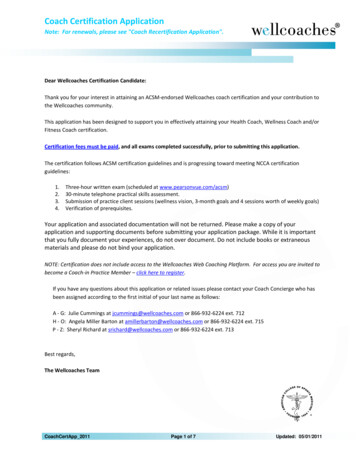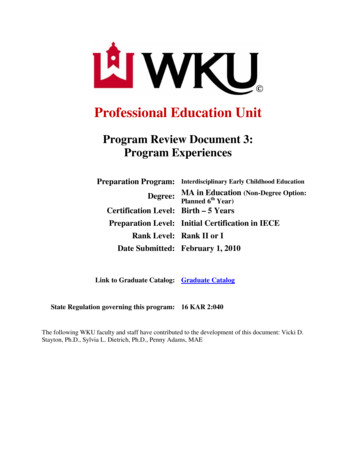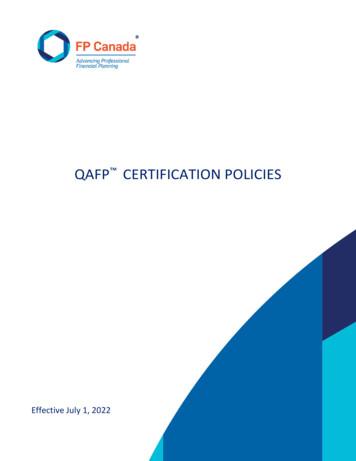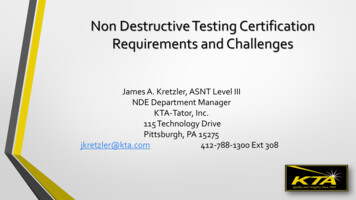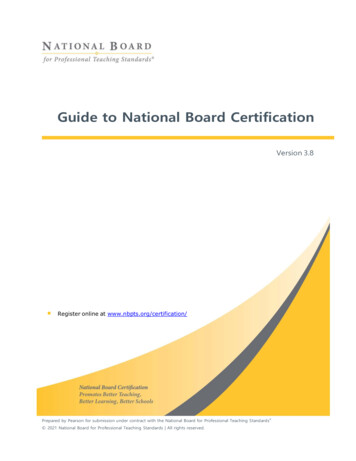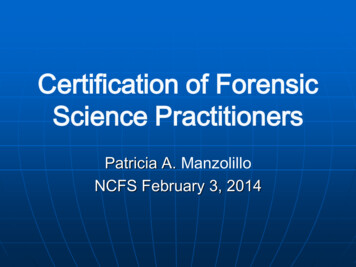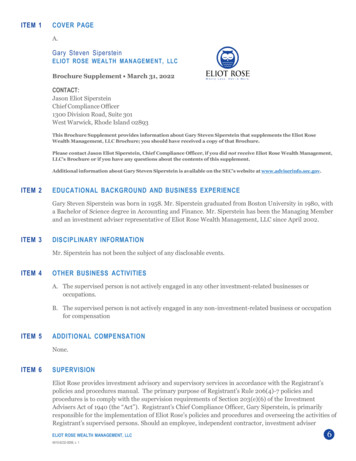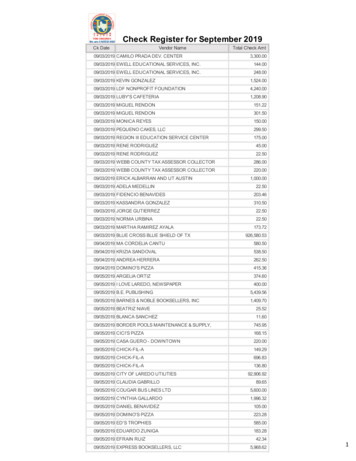
Transcription
Fire Fighter 2(NFPA Fire Fighter II)Certification Training Standards Guide (2019)Published January 2020California Department of Forestry and Fire ProtectionOffice of the State Fire MarshalState Fire Training
Fire Fighter 2Certification Training Standards Guide (2019)Publication Date: January 2020This CTS guide utilizes the following NFPA standards to provide the qualifications for State FireTraining’s Fire Fighter 1 (2019) certification: NFPA 1001: Standard for Fire Fighter Professional Qualifications (2019)State Fire Training coordinated the development of this CTS guide. Before its publication, theStatewide Training and Education Advisory Committee (STEAC) and the State Board of FireServices (SBFS) recommended this CTS guide for adoption by the Office of the State FireMarshal (OSFM).Cover photo courtesy of Craig Allyn Rose Photography.Published by State Fire Training.
Table of ContentsTable of ContentsAcknowledgements. 1How to Read a CTS Guide . 2Section 1: NFPA Requirements . 41-1: Identifying NFPA Requirements . 4Section 2: Fire Department Communications . 52-1: Completing a Basic Incident Report . 52-2: Communicating the Need for Team Assistance . 6Section 3: Fireground Operations . 73-1: Extinguishing an Ignitable Liquid Fire . 73-2: Controlling a Flammable Gas Cylinder Fire . 93-3: Coordinating an Interior Attack Line . 103-4: Protecting Evidence of Fire Cause and Origin . 12Section 4: Rescue Operations . 134-1: Extricating a Victim Entrapped in a Motor Vehicle . 134-2: Assisting Rescue Operation Teams . 14Section 5: Fire and Life Safety Initiatives, Preparedness, and Maintenance. 155-1: Performing a Fire Safety Survey in an Occupied Structure . 155-2: Presenting Fire Safety Information to Station Visitors or Small Groups . 165-3: Preparing a Preincident Survey . 175-4: Maintaining Power Plants, Power Tools, and Lighting Equipment . 185-5: Performing an Annual Service Test on Fire Hose . 19
AcknowledgmentsAcknowledgementsState Fire Training appreciates the hard work and accomplishments of those who build the solidfoundation on which this program continues to grow. State Fire Training gratefullyacknowledges the following individuals and organizations for their diligent efforts andcontributions that made the development and publication of this document possible.CAL FIRE Thom Porter, DirectorMike Richwine, Acting State Fire MarshalAndrew Henning, Chief of State Fire TrainingRon Coleman, Chair, Statewide Training and Education Advisory Committee (STEAC)Cadre – 2019 Development CadreLeadership Jim Eastman, Cadre Lead, Training Specialist III (RA), CAL FIRE; Deputy Chief (ret.),Sacramento Metro Fire DepartmentAllison L. Shaw, Editor, California State University, SacramentMembers Greg Belk, Division Chief, CAL FIRE San DiegoPaul Gonzalez, Fire Engineer, San Jose Fire Department; Coordinator, South Bay RegionalFire AcademyGarrett Huff, Battalion Chief, Santa Barbara County Fire Department; Secretary, SouthDivision, CalChiefs Training OfficersDonavan Lacy, Battalion Chief, Anderson Fire Protection District; Director of FireTechnology/EMS, Shasta Community College; Area 2 Director, CalChiefs Training OfficersAndrew Murtagh, Lieutenant, San Francisco Fire Department; Adjunct Faculty, FireTechnology Program, College of San MateoMichael Massone, Fire Captain, San Diego Federal Fire; Vice President, CaliforniaProfessional Fire Fighters; Representative, California Joint Apprenticeship CommitteeGerman Sierra, Fire Fighter/Paramedic (ret.), Oakland Fire Department; Faculty –Program Coordinator, Las Positas College; Representative, California Fire TechnologyDirectors’ Association (CFTDA)Shawn Tukua, Captain, Los Angeles Fire Department; State Fire Training Coordinator;Area 15 Director, CalChiefs Training OfficersRob Wheatley, Division Chief, Director of Fire Training, CAL FIRE Training CenterPublished January 2020Page 1 of 19
How to Read a CTS GuideHow to Read a CTS GuideOverviewA certification training standard (CTS) guide lists the requisite knowledge, skills, and jobperformance requirements an individual must complete in order to become certified in aspecific job function.It also documents and justifies the OSFM-approved revisions to the certification’s NFPAstandard, and identifies where each certification training standard is taught (course plan),tested (skill sheets), and validated (task book).Individuals aspiring to meet State Fire Training’s certification training standards must do so inaccordance with the codes, standards, regulations, policies, and standard operating proceduresapplicable within their own agency or jurisdiction.FormatEach certification training standard is comprised of eight sections.Section HeadingTraining standards are grouped by section headings that describe a general category. Forexample, the Fire Fighter 1 CTS guide includes the following section headings: NFPARequirements, Fire Department Communications, Fireground Operations, and Preparednessand Maintenance.Training Standard TitleThe training standard title provides a general description of the performance requirementcontained within the individual standard.AuthorityThe CTS guide references each individual standard with one or more paragraphs of thecorresponding National Fire Protection Association (NFPA) Professional Qualifications. Thisensures that each fire service function within California's certification system meets or exceedsNFPA standards.When California requirements exceed the NFPA standard, the CTS guide cites the Office of theState Fire Marshal as the authority and prints the corresponding information in italics.Job Performance RequirementsThis segment includes a written statement that describes a specific job-related task, the itemsan individual needs to complete the task, and measurable or observable outcomes.Published January 2020Page 2 of 19
How to Read a CTS GuideRequisite KnowledgeThis segment lists the knowledge that an individual must acquire in order to accomplish the jobperformance requirement.Requisite SkillsThis segment lists the skills that an individual must acquire in order to accomplish the jobperformance requirement.Content ModificationThis table documents and justifies any revisions to the NFPA standard that the development orvalidation cadres make during the development of a CTS guide.Cross ReferenceThis table documents where each training standard is taught (course plan), tested (skill sheets),and validated (task book).Published January 2020Page 3 of 19
Fire Fighter 2 - StructureSection 1: NFPA RequirementsSection 1: NFPA Requirements1-1: Identifying NFPA RequirementsAuthority1. NFPA 1001: Standard for Fire Fighter Professional Qualifications (2019) Paragraph 5.1, 5.1.1, 5.1.22. Office of the State Fire MarshalJob Performance RequirementThere is no job performance requirement identified for this training standard.Requisite Knowledge1. Describe the responsibilities of the Fire Fighter II in assuming and transferring commandwithin an incident command system2. Describe how to perform assigned duties in conformance with applicable NFPA standardsand other safety regulations and AHJ procedures3. Identify the role of a Fire Fighter II within the organizationRequisite Skills1. Determine the need for command2. Organize and coordinate an incident command system until command is transferred3. Function within an assigned role in an incident management systemContent ModificationBlockModificationJustificationRK 1 Changed “management” to California uses “command” and not “management”.“command”.RK 2 Added “standards”.Added for language consistency. NFPA is the organizationbut was being used to reference a document.RS 2 Changed “management” to California uses “command” and not “management”.“command”.Cross ReferenceCourse PlanSkill Sheet(s)Fire Fighter 2A, Topic 1-3: Fire Fighter 2 1-1: Organize an IncidentRoles and ResponsibilitiesManagement SystemPublished January 2020Task BookN/APage 4 of 19
Fire Fighter 2 – StructureSection 2: Fire Department CommunicationsSection 2: Fire Department Communications2-1: Completing a Basic Incident ReportAuthority1. NFPA 1001: Standard for Fire Fighter Professional Qualifications (2019) Paragraph 5.2.1Job Performance RequirementComplete a basic incident report, given the report forms, guidelines, and information, so thatall pertinent information is recorded, the information is accurate, and the report is complete.Requisite Knowledge1.2.3.4.5.Identify content requirements for basic incident reportsIdentify the purpose and usefulness of accurate reportsIdentify the consequences of inaccurate reportsDescribe how to obtain necessary informationIdentify required coding proceduresRequisite Skills1. Determine necessary codes2. Proof reports3. Operate fire department computers or other equipment necessary to complete reportsContent ModificationBlockCross ReferenceCourse PlanFire Fighter 2A, Topic 2-1: Completing aBasic Incident ReportPublished January 2020ModificationJustificationSkill Sheet(s)2-1: Complete a Basic IncidentReportTask Book(CTS 2-1)Page 5 of 19
Fire Fighter 2 – StructureSection 2: Fire Department Communications2-2: Communicating the Need for Team AssistanceAuthority1. NFPA 1001: Standard for Fire Fighter Professional Qualifications (2019) Paragraph 5.2.2Job Performance RequirementCommunicate the need for team assistance, given fire department communications equipment,SOPs, and a team, so that the supervisor is consistently informed of team needs, departmentalSOPs are followed, and the assignment is accomplished safely.Requisite Knowledge1. Describe SOPs for alarm assignments2. Describe fire department radio communication proceduresRequisite Skills1. Operate fire department communications equipmentContent ModificationBlockCross ReferenceModificationCourse PlanFire Fighter 2A, Topic 2-2: Communicatingthe Need for Team AssistancePublished January 2020JustificationSkill Sheet(s)2-2: Communicate the Need forTeam AssistanceTask Book(CTS 2-2)Page 6 of 19
Fire Fighter 2 – StructureSection 3: Fireground OperationsSection 3: Fireground Operations3-1: Extinguishing an Ignitable Liquid FireAuthority1. NFPA 1001: Standard for Fire Fighter Professional Qualifications (2019) Paragraph 5.3.12. Office of the State Fire MarshalJob Performance RequirementExtinguish an ignitable liquid fire, operating as a member of a team, given an assignment, anattack line, PPE, a foam proportioning device, a nozzle, foam concentrates (or suitablesubstitute), and a water supply, so that the correct type of foam concentrate is selected for thegiven fuel and conditions, a properly proportioned foam stream is applied to the surface of thefuel to create and maintain a foam blanket, fire is extinguished, reignition is prevented, teamprotection is maintained with a foam stream, and the hazard is faced until retreat to safe havenis reached.Requisite Knowledge1.2.3.4.5.6.7.8.9.Describe methods by which foam prevents or controls a hazardList principles by which foam is generatedIdentify causes for poor foam generation and corrective measuresDescribe the difference between hydrocarbon and polar solvent fuels and the concentratesthat work on eachIdentify the characteristics, uses, and limitations of fire-fighting foamsDescribe the advantages and disadvantages of using fog nozzles versus foam nozzles forfoam applicationDescribe foam stream application techniquesList hazards associated with foam usageDescribe methods to reduce or avoid hazardsRequisite Skills1.2.3.4.Prepare a foam concentrate supply for useAssemble foam stream componentsMaster various foam application techniquesApproach and retreat from spills as part of a coordinated team.Published January 2020Page 7 of 19
Fire Fighter 2 – StructureSection 3: Fireground OperationsContent ModificationBlockModificationJPRAdded “(or suitablesubstitute)”.Cross ReferenceJustificationEach California county has different rules dictated by CalEPA.Many counties are unable to use foam during trainingexercises.Course PlanFire Fighter 2A, Topic 3-1: Extinguishing anIgnitable Liquid FirePublished January 2020Skill Sheet(s)3-1: Extinguish an Ignitable LiquidFireTask Book(CTS 3-1)Page 8 of 19
Fire Fighter 2 – StructureSection 3: Fireground Operations3-2: Controlling a Flammable Gas Cylinder FireAuthority1. NFPA 1001: Standard for Fire Fighter Professional Qualifications (2019) Paragraph 5.3.3Job Performance RequirementControl a flammable gas cylinder fire, operating as a member of a team, given an assignment, acylinder outside of a structure, an attack line, PPE, and tools, so that crew integrity ismaintained, contents are identified, safe havens are identified prior to advancing, open valvesare closed, flames are not extinguished unless the leaking gas is eliminated, the cylinder iscooled, cylinder integrity is evaluated, hazardous conditions are recognized and acted upon,and the cylinder is faced during approach and retreat.Requisite Knowledge1. Identify characteristics of pressurized flammable gases2. List elements of a gas cylinder3. Describe effects of heat and pressure on closed cylinders4. Describe boiling liquid expanding vapor explosion (BLEVE) signs and effects5. Describe methods for identifying contents6. Describe how to identify safe havens before approaching flammable gas cylinder fires7. Describe water stream usage and demands for pressurized cylinder fires8. Describe what to do if the fire is prematurely extinguished9. Identify valve types and their operation10. Describe alternative actions related to various hazards and when to retreatRequisite Skills1.2.3.4.5.Execute effective advances and retreatsApply various techniques for water applicationAssess cylinder integrity and changing cylinder conditionsOperate control valvesChoose effective procedures when conditions changeContent ModificationBlockCross ReferenceCourse PlanFire Fighter 2A, Topic 3-2: Controlling aFlammable Gas Cylinder FirePublished January 2020ModificationJustificationSkill Sheet(s)3-2: Control a Flammable GasCylinder FireTask Book(CTS 3-2)Page 9 of 19
Fire Fighter 2 – StructureSection 3: Fireground Operations3-3: Coordinating an Interior Attack LineAuthority1. NFPA 1001: Standard for Fire Fighter Professional Qualifications (2019) Paragraph 5.3.22. Office of the State Fire MarshalJob Performance RequirementCoordinate an interior attack line for a team’s accomplishment of an assignment in a structurefire, given attack lines, personnel, PPE, and tools, so that crew integrity is established; attacktechniques are selected for the given level of the fire (e.g., attic, grade level, upper levels, orbasement); attack techniques are communicated to the attack teams; constant teamcoordination is maintained; fire growth and development is continuously evaluated; search,rescue, and ventilation requirements are communicated or managed; hazards are reported tothe attack teams; and incident command is apprised of changing conditions.Requisite Knowledge1.2.3.4.5.6.7.8.9.Describe how to select the nozzle and hose for fire attack, given different fire situationsDescribe how to select adapters and appliances to be used for specific fireground situationsIdentify dangerous building conditions created by fire and fire suppression activitiesDescribe indicators of building collapseDescribe the effects of fire and fire suppression activities on wood, masonry (brick, block,stone), cast iron, steel, reinforced concrete, gypsum wallboard, glass, and plaster on lathDescribe coordinated search and rescue and ventilation proceduresList indicators of structural instabilityDescribe suppression approaches and practices for various types of structural firesDescribe the association between specific tools and special forcible entry needsRequisite Skills1. Assemble a team2. Choose attack techniques for various levels of a fire (e.g., attic, grade level, upper levels, orbasement)3. Evaluate and forecast a fire’s growth and development4. Select tools for forcible entry5. Incorporate search and rescue procedures and ventilation procedures in the completion ofthe attack team efforts6. Determine developing hazardous building or fire conditionsContent ModificationBlockModificationRK 6 Added“coordinated”.Published January 2020JustificationAdded to clarify the relationship between very differentactivities.Page 10 of 19
Fire Fighter 2 – StructureSection 3: Fireground OperationsCross ReferenceCourse PlanFire Fighter 2A, Topic 3-3: Coordinating anInterior Attack LinePublished January 2020Skill Sheet(s)3-3: Coordinate an Interior FireAttack LineTask Book(CTS 3-3)Page 11 of 19
Fire Fighter 2 – StructureSection 3: Fireground Operations3-4: Protecting Evidence of Fire Cause and OriginAuthority1. NFPA 1001: Standard for Fire Fighter Professional Qualifications (2019) Paragraph 5.3.42. Office of the State Fire MarshalJob Performance RequirementProtect evidence of fire cause and origin, given a flashlight, PPE, and overhaul tools, so that theevidence is noted and protected from further disturbance until investigators can arrive on thescene.Requisite Knowledge1.2.3.4.Identify methods to assess origin and causeList types of evidenceDescribe means to protect various types of evidenceIdentify the role and relationship of Fire Fighter IIs, criminal investigators, and insuranceinvestigators in fire investigations5. Describe the effects and problems associated with removing property or evidence from thesceneRequisite Skills1. Locate the fire’s origin area2. Recognize possible causes3. Protect the evidenceContent ModificationBlockJPRModificationAdded “PPE”.Cross ReferenceJustificationOmitted by NFPA but required for JPR.Course PlanFire Fighter 2A, Topic 3-4: ProtectingEvidence of Fire Cause and OriginPublished January 2020Skill Sheet(s)3-4: Protect Evidence of Fire Causeand OriginTask Book(CTS 3-4)Page 12 of 19
Fire Fighter 2 – StructureSection 4: Rescue OperationsSection 4: Rescue Operations4-1: Extricating a Victim Entrapped in a Motor VehicleAuthority1. NFPA 1001: Standard for Fire Fighter Professional Qualifications (2019) Paragraph 5.4.12. Office of the State Fire MarshalJob Performance RequirementExtricate a victim entrapped in a motor vehicle as part of a team, given stabilization andextrication tools, a vehicle, and PPE, so that the vehicle is stabilized, the victim is disentangledwithout further injury, and hazards are managed.Requisite Knowledge1.2.3.4.5.Describe the fire department’s role at a vehicle accidentDescribe points of strength and weakness in auto body constructionDescribe the dangers associated with vehicle components and systemsDescribe the uses and limitations of hand and power extrication equipmentDescribe safety procedures when using various types of extrication equipmentRequisite Skills1.2.3.4.Operate hand and power tools used for forcible entry and rescue as designedUse cribbing and shoring materialUse stabilization tools and equipmentChoose and apply appropriate techniques for moving or removing vehicle roofs, doors,seats, windshields, windows, steering wheels or columns, and the dashboardContent ModificationBlockModificationJPRAdded “a vehicle, and PPE”.RS 4Added “seats”.Cross ReferenceCourse PlanFire Fighter 2A, Topic 4-1: Extricating aVictim Trapped in a Motor VehiclePublished January 2020JustificationOmitted by NFPA but required to complete JPR.Seats my also need to be removed to extricate a victim.Skill Sheet(s)4-1: Extricate a Victim Entrapped in aVehicle FireTask Book(CTS 4-1)Page 13 of 19
Fire Fighter 2 – StructureSection 4: Rescue Operations4-2: Assisting Rescue Operation TeamsAuthority1. NFPA 1001: Standard for Fire Fighter Professional Qualifications (2019) Paragraph 5.4.2Job Performance RequirementAssist rescue operation teams, given standard operating procedures, necessary rescueequipment, and an assignment, so that procedures are followed, rescue items are recognizedand retrieved in the time as prescribed by the AHJ, and the assignment is completed.Requisite Knowledge1.2.3.4.Describes the fire fighter’s role at a technical rescue operationIdentify hazards associated with technical rescue operationsDescribe types and uses for rescue toolsIdentify rescue practices and goalsRequisite Skills1. Identify and retrieve various types of rescue tools2. Establish public barriers3. Assist rescue teams as a member of the team when assignedContent ModificationBlockCross ReferenceModificationCourse PlanFire Fighter 2A, Topic 4-2: Assisting RescueOperation TeamsPublished January 2020JustificationSkill Sheet(s)Task Book4-2: Assist a Rescue Operations Team (CTS 4-2)Page 14 of 19
Fire Fighter 2 – StructureSection 5: Fire and Life Safety Initiatives, Preparedness, and MaintenanceSection 5: Fire and Life Safety Initiatives, Preparedness, andMaintenance5-1: Performing a Fire Safety Survey in an Occupied StructureAuthority1. NFPA 1001: Standard for Fire Fighter Professional Qualifications (2019) Paragraph 5.5.1Job Performance RequirementPerform a fire safety survey in an occupied structure, given survey forms and procedures, sothat fire and life safety hazards are identified, recommendations for their correction are madeto the occupant, and unresolved issues are referred to the proper authority.Requisite Knowledge1. Describe organizational policy and procedures2. List common causes of fire and their prevention3. Describe the importance of a fire safety survey and public fire education programs to firedepartment public relations and the community4. Identify referral proceduresRequisite Skills1.2.3.4.Complete formsRecognize hazardsMatch findings to preapproved recommendationsEffectively communicate findings to occupants or referralsContent ModificationBlockCross ReferenceModificationCourse PlanFire Fighter 2A, Topic 5-1: Performing aFire and Life Safety Survey in an OccupiedStructurePublished January 2020JustificationSkill Sheet(s)5-1: Perform a Fire Safety Survey inan Occupied StructureTask Book(CTS 5-1)Page 15 of 19
Fire Fighter 2 – StructureSection 5: Fire and Life Safety Initiatives, Preparedness, and Maintenance5-2: Presenting Fire Safety Information to Station Visitors or Small GroupsAuthority1. NFPA 1001: Standard for Fire Fighter Professional Qualifications (2019) Paragraph 5.5.2Job Performance RequirementPresent fire safety information to station visitors or small groups, given prepared materials, sothat all information is presented, the information is accurate, and questions are answered orreferred.Requisite Knowledge1. Describe parts of informational materials and how to use them2. Identify basic presentation skills3. Describe departmental standard operating procedures for giving fire station toursRequisite Skills1. Document presentations2. Use prepared materialsContent ModificationBlockCross ReferenceCourse PlanFire Fighter 2A, Topic 5-2: Presenting FireSafety Information to Station Visitors orSmall GroupsPublished January 2020ModificationJustificationSkill Sheet(s)5-2: Present Fire Safety InformationTask Book(CTS 5-2)Page 16 of 19
Fire Fighter 2 – StructureSection 5: Fire and Life Safety Initiatives, Preparedness, and Maintenance5-3: Preparing a Preincident SurveyAuthority1. NFPA 1001: Standard for Fire Fighter Professional Qualifications (2019) Paragraph 5.5.3Job Performance RequirementPrepare a preincident survey, given forms, necessary tools, and an assignment, so that allrequired occupancy information is recorded, items of concern are noted, and accurate sketchesor diagrams are prepared.Requisite Knowledge1. Identify sources of water supply for fire protection2. Describe the fundamentals of fire suppression and detection systems3. Identify common symbols used in diagramming construction features, utilities, hazards, andfire protection systems4. Describe departmental requirements for a preincident survey and form completion5. Identify the importance of accurate diagramsRequisite Skills1.2.3.4.Identify the components of fire suppression and detection systemsSketch the site, buildings, and special featuresDetect hazards and special considerations to include in the preincident sketchComplete all related departmental formsContent ModificationBlockCross ReferenceCourse PlanFire Fighter 2A, Topic 5-3: Preparing aPreincident SurveyPublished January 2020ModificationJustificationSkill Sheet(s)5-3: Prepare a Preincident SurveyTask Book(CTS 5-3)Page 17 of 19
Fire Fighter 2 – StructureSection 5: Fire and Life Safety Initiatives, Preparedness, and Maintenance5-4: Maintaining Power Plants, Power Tools, and Lighting EquipmentAuthority1. NFPA 1001: Standard for Fire Fighter Professional Qualifications (2019) Paragraph 5.5.4Job Performance RequirementMaintain power plants, power tools, and lighting equipment, given tools and manufacturers’instructions, so that equipment is clean and maintained according to manufacturer anddepartmental guidelines, maintenance is recorded, and equipment is placed in a ready state orreported otherwise.Requisite Knowledge1. Identify types of cleaning methods2. Describe correct use of cleaning solvents3. Describe manufacturer and departmental guidelines for maintaining equipment and itsdocumentation4. Identify problem-reporting practicesRequisite Skills1.2.3.4.Select correct toolsFollow guidelinesComplete recording and reporting proceduresOperate power plants, power tools, and lighting equipmentContent ModificationBlockCross ReferenceCourse PlanFire Fighter 2A, Topic 5-4: MaintainingPower Plants, Power Tools, and LightingEquipmentPublished January 2020ModificationJustificationSkill Sheet(s)5-4: Maintain Power Plants, Tools,and EquipmentTask Book(CTS 5-4)Page 18 of 19
Fire Fighter 2 – StructureSection 5: Fire and Life Safety Initiatives, Preparedness, and Maintenance5-5: Performing an Annual Service Test on Fire HoseAuthority1. NFPA 1001: Standard for Fire Fighter Professional Qualifications (2019) Paragraph 5.5.5Job Performance RequirementPerform an annual service test on fire hose, given an apparatus or hose testing device, amarking device, pressure gauges, a timer, record sheets, and related equipment, so thatprocedures are followed, the condition of the hose is evaluated, any damaged hose is removedfrom service, and the results are recorded.Requisite Knowledge1. Describe procedures for safely conducting hose service testing2. Identify indicators that dictate any hose be removed from service3. Describe recording procedures for hose test resultsRequisite Skills1. Operate hose testing equipment and nozzles2. Record resultsContent ModificationBlockModificationJPRChanged “a pump” to “an apparatusor hose testing device”.Cross ReferenceCourse PlanFire Fighter 2A, Topic 5-5: Performing anAnnual Service Test on a Fire HosePublished January 2020JustificationThis is the generic term used in the field andprovides more options for testing.Skill Sheet(s)5-5: Perform an Annual Service Teston a Fire HoseTask Book(CTS 5-5)Page 19 of 19
This CTS guide utilizes the following NFPA standards to provide the qualifications for State Fire Training's Fire Fighter 1 (2019) certification: NFPA 1001: Standard for Fire Fighter Professional Qualifications (2019) State Fire Training coordinated the development of this CTS guide. Before its publication, the


